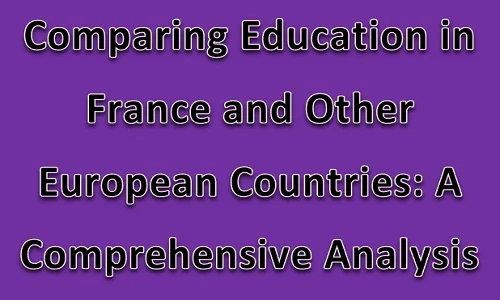Education systems across Europe vary significantly, with each country adopting unique structures, policies, and teaching methodologies. France, known for its centralized education system and rigorous academic standards, presents a striking contrast to many of its European counterparts. This article explores key differences between the French education system and those of other European countries, focusing on curriculum structure, higher education accessibility, and teaching methodologies
Centralization vs. Decentralization
One of the most distinguishing
features of the French education system is its high degree of centralization.
The Ministry of National Education controls curricula, teacher training, and
examination standards, ensuring uniformity across the country. In contrast,
many European nations, such as Germany and Sweden, have decentralized systems
where regional or local authorities have significant control over education
policies. This allows for more flexibility in curriculum adaptation, catering
to regional needs and cultural diversity.
Curriculum Structure and Rigor
The French curriculum is known for
its academic rigor and emphasis on theoretical knowledge. From an early age,
students follow a structured program that includes French, mathematics,
sciences, history, philosophy, and foreign languages. High school students must
pass the "Baccalauréat" (Le Bac), a highly demanding examination that
determines university eligibility.
In contrast, countries like
Finland and the Netherlands emphasize a more flexible and student-centered
approach. Finland, for instance, is renowned for its holistic education model,
where students have fewer standardized tests and more freedom to explore
subjects based on their interests. Similarly, Scandinavian countries prioritize
creativity, critical thinking, and problem-solving over rote memorization.
Higher Education Accessibility
Higher education in France is
relatively affordable compared to countries like the UK and the US. Public
universities charge minimal tuition fees, making it accessible to a broad range
of students. However, the highly competitive "Grandes Écoles" system,
which offers elite education in engineering, business, and administration,
poses challenges in accessibility due to stringent entrance exams.
Conversely, many European
countries offer diverse pathways to higher education. Germany, for instance,
provides tuition-free university education for both domestic and international
students. The Netherlands has an extensive network of applied sciences
universities, offering practical and industry-oriented education alongside
traditional universities. The UK's system, although prestigious, is among the
most expensive, with tuition fees reaching tens of thousands of pounds per year.
Teaching Methodologies: Rote Learning vs. Critical Thinking
French education has historically
leaned toward a teacher-centered approach, emphasizing memorization,
discipline, and theoretical instruction. Class sizes tend to be large, and
student-teacher interactions are often formal. While this method ensures strong
academic foundations, critics argue that it stifles creativity and independent
thought.
On the other hand, Nordic
countries, such as Finland and Denmark, focus on fostering creativity and
critical thinking. Finnish schools, for example, emphasize group work,
discussion-based learning, and experiential education, allowing students to
develop problem-solving skills and adaptability. The UK's system also promotes
analytical thinking, with a focus on student-led discussions, coursework, and
project-based assessments.
Vocational Education and Career Readiness
France has a strong vocational
education system, offering students specialized technical training through
"Lycées Professionnels" and apprenticeship programs. However,
vocational training is often viewed as less prestigious compared to academic
pathways. In contrast, Germany’s "dual education system" is
considered one of the best in the world, integrating classroom learning with
hands-on work experience in companies. This ensures a seamless transition from
education to employment, reducing youth unemployment rates significantly.
Student Well-being and School-Life Balance
French students face long school
hours, with primary and secondary education often running from 8 AM to 5 PM,
accompanied by extensive homework. The competitive nature of exams like
"Le Bac" can create high-stress environments. In contrast, Finland’s
shorter school days and minimal homework policies prioritize student well-being
and mental health, contributing to high academic performance and student satisfaction.
Conclusion
While the French education system is rigorous, well-structured, and accessible, it contrasts significantly with other European models that prioritize flexibility, student well-being, and alternative learning methods. Countries like Finland, Germany, and the Netherlands offer innovative approaches that emphasize critical thinking, career readiness, and a balanced student life. Understanding these differences can help policymakers, educators, and students make informed decisions about the best educational practices for future generations.

